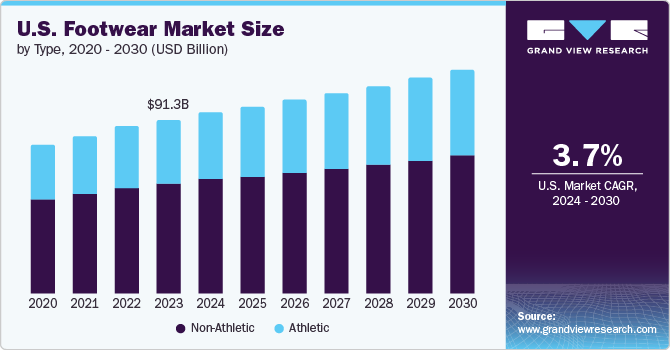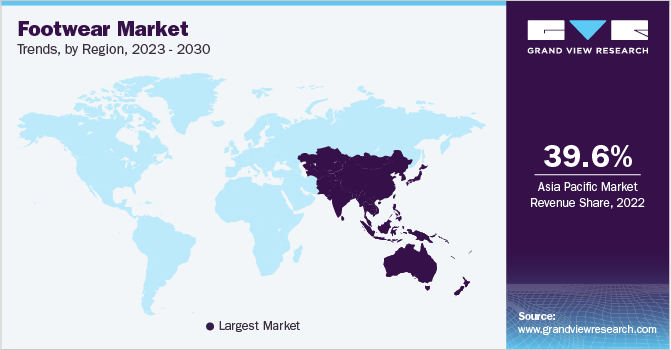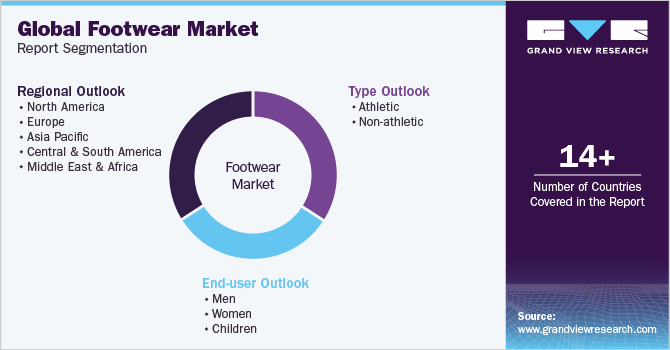- Home
- »
- Clothing, Footwear & Accessories
- »
-
Footwear Market Size, Share & Trends Analysis Report, 2030GVR Report cover
![Footwear Market Size, Share & Trends Report]()
Footwear Market Size, Share & Trends Analysis Report By Type (Athletic Footwear, Non-Athletic Footwear), By End-user (Men, Women, Children), By Region, And Segment Forecasts, 2024 - 2030
- Report ID: GVR-3-68038-396-6
- Number of Report Pages: 122
- Format: PDF, Horizon Databook
- Historical Range: 2018 - 2023
- Forecast Period: 2024 - 2030
- Industry: Consumer Goods
Footwear Market Size & Trends
The global footwear market size was estimated at USD 438.62 billion in 2023 and is anticipated to grow at a CAGR of 4.3% from 2024 to 2030. Rising disposable incomes, particularly in emerging economies, have increased spending on new fashionable footwear. Moreover, numerous brands are launching limited-edition shoes and premium and luxury footwear for consumers aiming to live aspirational lifestyles. According to the World Footwear Yearbook 2023, released by World Footwear, footwear consumption reached 20.6 billion pairs in 2022, an increase of 8.42% compared to 2021. Consumers prioritize comfort and functionality, leading to a surge in demand for athletic shoes, sneakers, and casual footwear. The growing popularity of online shopping platforms and social media marketing have made it easier for consumers to access a wider variety of shoe options and brands, further boosting sales.

Moreover, increasing health and wellness awareness drives the demand for specialized footwear like orthopedic and sports shoes. Technological advancements, such as the use of 3D printing and advanced materials, are creating new opportunities for innovation and customization in product design. Advanced materials, such as durable and lightweight composites, breathable fabrics, and eco-friendly bio-based materials, further push the boundaries of footgear innovation. For instance, Nike launched a new recyclable shoe, the Nike ISPA Link Axis, which uses several interlocking components, fewer materials than conventional shoes, and zero glue. The shoe uses a 100% polyester Flyknit upper that is seamlessly engineered over the outsole and boasts 100% recycled TPU tooling made from repurposed airbag material. Growing awareness of the importance of foot health has led to increased specialized shoes that provide arch support, cushioning, and breathability.
Moreover, the growing emphasis on health and fitness further boosts the athletic shoe market, as individuals prioritize comfort and performance during physical activities. Moreover, rapid growth in the global population, particularly in urban areas, has increased the demand for footwear, especially for daily use and fashionable and comfortable styles. Footwear companies offer customization and personalization options to cater to individual preferences and create unique products. Moreover, the increasing product availability through various distribution channels, such as e-commerce, sports shops, and footwear stores, has made purchasing these products more convenient for consumers. Online marketplaces and brand websites offer a wide selection of footwear options, allowing consumers to compare prices and styles easily. Moreover, the growing popularity of athleisure products, combining athletic and casual elements has further boosted sales.
Footwear brands collaborate with fashion designers, celebrities, and other brands to create limited-edition collections and capture new market segments. Consumers use social media to discover new trends and shoe styles, and they are often influenced by the footgear choices of their favorite celebrities and influencers. This trend is expected to continue, as social media remains a major platform for fashion and lifestyle inspiration. For instance, in October 2023, Geox S.p.A. collaborated with renowned Spanish actress Penélope Cruz to create a collection of clothing and footwear products for the spring/summer of 2024. The standout pieces in this collection are the adaptable jackets and day-to-night footwear crafted by Geox using state-of-the-art technology and high-quality materials.
Market Concentration & Characteristics
The market is characterized by a high degree of innovation, driven by technological advancements and changing consumer preferences. Manufacturers continuously introduce new materials, designs, and technologies to meet evolving demands for comfort, style, and functionality. This innovation fuels market growth and fosters competition among brands. The market also experiences significant levels of M&A activities as companies seek to expand their market share, gain access to new technologies, or consolidate their position in the industry. M&A can create larger, more powerful players, influencing market dynamics and competitive landscapes.
Regulations play a crucial role in the footwear industry, particularly regarding safety standards, environmental concerns, and labor practices. Compliance with these regulations ensures product quality, protects consumers, and minimizes environmental impact. Regulatory changes can significantly impact market participants, requiring them to adapt their production processes and strategies. The market faces competition from product substitutes, such as slippers and sandals. These alternatives offer varying levels of comfort, style, and functionality, and their popularity can impact demand for traditional footwear products. Understanding the competitive landscape and consumer preferences for substitutes is essential for market players to stay competitive and adapt to changing market dynamics.

Type Insights
The non-athletic footwear segment accounted for a revenue share of 66.54% in 2023. Factors, such as the launch of seasonal shoe collections, changing fashion trends, and increasing popularity of stylish and trendy footwear, have driven the demand for non-athletic shoes, including dress shoes, casual sneakers, and sandals. Consumers are increasingly seeking comfortable and versatile footwear suitable for various occasions, from casual outings to work environments. This drives the demand for non-athletic shoes with features like cushioning and breathability. Moreover, the demand for comfortable and supportive non-athletic shoes, such as orthopedic and walking shoes, has increased with the rising geriatric population.
The athletic footwear segment is anticipated to witness a CAGR of 5.0% from 2024 to 2030. Athletic footwear is popular among individuals who engage in various sports and fitness activities and those seeking comfortable and supportive footwear for everyday use. The segment growth is driven by factors, such as rising health consciousness, increasing participation in sports and fitness activities, and growing popularity of athleisure wear. In addition, endorsements from athletes, celebrities, and influencers have played a significant role in driving consumer interest and demand for specific athletic shoe brands and styles. For instance, in January 2024, Brooks announced its partnership with Kara Goucher, a popular icon in American distance running, to enhance its promotional efforts through the Hyperion House, a pop-up experience set to feature prominently at key events within the running sports culture.
End-user Insights
The women's footwear segment accounted for a revenue share of 47.68% in 2023. The women's footwear market is highly diverse, offering many styles and designs to meet the multifaceted needs of women. Heels, flats, boots, sandals, and sneakers are among the most popular categories. Moreover, fashion trends and aesthetics are important in driving consumer preferences. Consumers seek footwear that provides style and comfort, whether for daily wear, exercise, or special occasions. In March 2024, a Reliance Retail brand, Lee Cooper, launched The Lee Cooper’s Spring Summer’24 women's footwear collection, “Shoes Don’t Judge,” which encompasses unique style, a wide array of colors, and materials suited for all occasions.

The children's footwear segment is estimated to grow at a CAGR of 4.2% from 2024 to 2030. The children's foot care industry focuses on providing comfortable, durable, and age-appropriate footwear. Sneakers and athletic shoes are popular for boys and girls, prioritizing support and functionality. School shoes, sandals, and boots are also essential categories designed to meet the specific needs of different age groups and activities. Parents are becoming more aware of the importance of proper foot support and development, leading them to seek shoe brands that prioritize comfort features, such as cushioning, arch support, and breathable materials. For instance, in April 2023, an Indian footwear startup, Aretto, announced the launch of shoes that expand as the child grows. These shoes are designed to be flexible and comfortable and provide the right fit for growing feet.
Regional Insights
The footwear market in North America held a revenue share of 25% in 2023. North American consumers prioritize footwear that reflects current trends, personal style, and individual expression. As such, brands and retailers constantly innovate and introduce new designs, colors, and styles to cater to evolving fashion tastes and preferences. In addition, the growing focus on health and wellness plays a crucial role in driving regional industry growth. With the rising awareness of the importance of foot health and comfort, consumers seek footwear that offers style and functionality. This has led to a rise in demand for athletic and athleisure footwear and comfortable and supportive shoes for everyday wear.

U.S. Footwear Market Trends
The U.S. footwear market is expected to grow at a CAGR of 3.7% from 2024 to 2030 owing to the presence of both domestic and international brands, with a wide spectrum of price points and styles. The demand for footgear is driven by factors, such as fashion trends, seasonal changes, and consumer preferences for comfort, durability, and aesthetics. Moreover,consumers are often influenced by celebrities, social media influencers, and fashion designers, leading to changing preferences and the introduction of new designs and collections regularly. In addition, strong brand recognition and effective marketing strategies play a crucial role in driving consumer demand and loyalty toward specific footwear brands, particularly in the athletic and luxury segments.
Europe Footwear Market Trends
The footwear market in Europe is set to grow at a CAGR of about 3.6% from 2024 to 2030. Brands and retailers in the region are leveraging digital platforms to reach a broader audience, enhance customer engagement, and offer personalized shopping experiences, thereby driving sales and market penetration.European shoes are also known for their long-lasting quality and elegance and are often made with premium materials like leather sourced from exclusive tanneries. Some European shoe brands, like Ethletic and Etiko, also prioritize sustainability and ethical production practices.
Asia Pacific Footwear Market Trends
The Asia Pacific footwear market held a share of over 40% in 2023. The regional market growth is driven by factors, such as rising disposable income and a vast population base. Countries including China, India, and Japan are major players in this region. The increasing penetration of e-commerce and digital platforms has significantly contributed to the expansion of the regional market. With the proliferation of smartphones and internet connectivity, consumers have greater access to a wide array of shoe options, leading to increased competition among both local and international brands. For instance, in March 2020, Japanese online fashion website ZOZO, Inc. launched ZOZOSHOES, a new platform exclusively dedicated to footwear that allows its users to buy shoes in the right size without ever having to try on the product. ZOZOSHOES is anat-home measurement device that scans feet in 3D and provides its customers with an enhanced online shoe shopping experience and delivers it using its state-of-the-art technology.
Central & South America Footwear Market Trends
The footwear market in Central & South America is set to grow at a CAGR of about 4.2% from 2024 to 2030.The regional market benefits from the expansion of retail channels and e-commerce platforms. Increased accessibility to a wide range of shoe options through online shopping platforms has made it easier for consumers to browse and purchase footgear from the comfort of their homes.
Middle East & Africa Footwear Market Trends
The Middle East & Africa footwear market is set to grow at a CAGR of about 4.5% from 2024 to 2030. Consumers in this region have a strong demand for both traditional and modern footwear styles. Moreover, the growing popularity of sports and outdoor activities, particularly in the GCC countries, has fueled the demand for athletic and outdoor footwear products designed for various sports and leisure activities. Foot care products can be found in markets, shopping malls, and online platforms, allowing consumers to choose from a variety of options. Footwear like PVC has gained popularity across the Middle East, primarily owing to the region's warm climate, cultural practices, and lifestyle preferences. Many international PVC shoe brands, such as Crocs, Inc., Havaianas, Decathlon SE, and Bata Corporation, and local manufacturers like Al Jazira Plastic Industries, cater to this regional market.
Key Footwear Company Insights
Nike, Inc., Adidas AG, SKECHERS USA, Inc., Puma SE, Crocs Retail, LLC, and Wolverine Worldwide, Inc. are some of the dominant players operating in this market. The global footwear market is characterized by intense competition. These companies invest heavily in R&D to develop innovative products by using sustainable materials, design, and advanced manufacturing processes. This includes designs, such as minimalist mules, funky styles, chunky sneakers, and footwear, with bold colors and patterns. Moreover, collaboration with renowned designers, celebrity endorsements, and the integration of cutting-edge technologies are common strategies used by companies to differentiate themselves and gain market share.
Key Footwear Companies:
The following are the leading companies in the footwear market. These companies collectively hold the largest market share and dictate industry trends.
- Nike, Inc.
- Adidas AG
- SKECHERS USA, Inc.
- Puma SE
- Crocs Retail, LLC
- Wolverine Worldwide, Inc.
- ECCO Sko A/S
- Under Armour, Inc.
- Timberland
- Geox S.p.A.
Recent Developments
-
In March 2024, Timberland Pro broadened its product range to include footwear tailored for the hospitality sector. Through its specialized division for skilled trade professionals, Timberland launched the Burbank Collection, marking the brand's inaugural line of footwear designed specifically for workers in the restaurant and hotel sectors. The collection features industry-standard all-black designs meticulously crafted to prioritize comfort, durability, protection, and slip resistance
-
In February 2024, Puma SE introduced the Spirex Trail shoes in prairie tan and grey fog. Inspired by Y2K-era running spikes, the Spirex combines technical features with street-style aesthetics, drawing from PUMA's heritage of speed. The shoe features an asymmetrical composition with fine mesh, nubuck, and suede materials, seamlessly integrating PUMA's iconic Formstrip
-
In February 2024, ON Holdings AG announced the opening of its latest store in Portland, Oregon, U.S., as part of its global retail expansion strategy. The new store will feature the brand’s latest footwear, apparel, and accessories, offering comprehensive collections tailored for running, trail activities, and everyday movement
Footwear Market Report Scope
Report Attribute
Details
Market size value in 2024
USD 457.09 billion
Revenue forecast in 2030
USD 588.22 billion
Growth rate
CAGR of 4.3% from 2024 to 2030
Actuals
2018 - 2023
Forecast period
2024 - 2030
Quantitative units
Revenue in USD Billion and CAGR from 2024 to 2030
Report coverage
Revenue forecast, company ranking, competitive landscape, growth factors, and trends
Segments covered
Type, end-user, region
Regional scope
North America; Europe; Asia Pacific; Central & South America; Middle East & Africa
Country scope
U.S.; Canada; Mexico; Germany; UK; Spain; Italy; France; China; India; Japan; South Korea; Australia & New Zealand; Brazil; South Africa
Key companies profiled
Nike, Inc.; Adidas AG; SKECHERS USA, Inc.; Puma SE; Crocs Retail, LLC; Wolverine Worldwide, Inc.; ECCO Sko A/S; Under Armour, Inc.; Timberland; Geox S.p.A.
Customization scope
Free report customization (equivalent up to 8 analysts working days) with purchase. Addition or alteration to country, regional & segment scope
Pricing and purchase options
Avail customized purchase options to meet your exact research needs. Explore purchase options
Global Footwear Market Report Segmentation
This report forecasts revenue growth at global, regional, and country levels and provides an analysis of the latest trends in each of the sub-segments from 2018 to 2030. For this study, Grand View Research has segmented the footwear market report based on type, end-user, and region:

-
Footwear Type Outlook (Revenue in USD Billion, 2018 - 2030)
-
Athletic
-
Non-Athletic
-
-
Footwear End-user Outlook (Revenue, USD Billion; 2018 - 2030)
-
Men
-
Women
-
Children
-
-
Footwear Regional Outlook (Revenue, USD Billion, 2018 - 2030)
-
North America
-
U.S.
-
Canada
-
Mexico
-
-
Europe
-
Germany
-
UK
-
France
-
Italy
-
Spain
-
-
Asia Pacific
-
China
-
Japan
-
India
-
Australia & New Zealand
-
South Korea
-
-
Central & South America
-
Brazil
-
-
Middle East & Africa
-
South Africa
-
-
Frequently Asked Questions About This Report
b. The global footwear market was estimated at USD 438.62 billion in 2023 and is expected to reach USD 457.09 billion in 2024.
b. The global footwear market is expected to grow at a compound annual growth rate of 4.3% from 2024 to 2030 to reach USD 588.22 billion by 2030.
b. Asia Pacific dominated the footwear market with a share of 40.0% in 2023. This is mainly attributed to the high demand for footwear from densely populated countries in the region including China, India and Japan where demand for footwear is on a large scale.
b. Some key players operating in the footwear market include Nike, Inc.; Adidas America, Inc.; PUMA; Geox S.p.A.; Timberland; Skechers USA, Inc.; Ecco Sko A/S; Crocs Retail, Inc.; Under Armour Inc.; and Wolverine World Wide, Inc.
b. Key factors that are driving the footwear market growth include the rising popularity of leather shoes and the increasing adoption of footwear made from sustainable materials. Moreover, changing fashion trends and innovative footwear designs offered by manufacturers are expected to further drive the market over the forecast period.
Share this report with your colleague or friend.
![gvr icn]()
NEED A CUSTOM REPORT?
We can customize every report - free of charge - including purchasing stand-alone sections or country-level reports, as well as offer affordable discounts for start-ups & universities. Contact us now
![Certified Icon]()
We are GDPR and CCPA compliant! Your transaction & personal information is safe and secure. For more details, please read our privacy policy.
We are committed towards customer satisfaction, and quality service.
"The quality of research they have done for us has been excellent."





